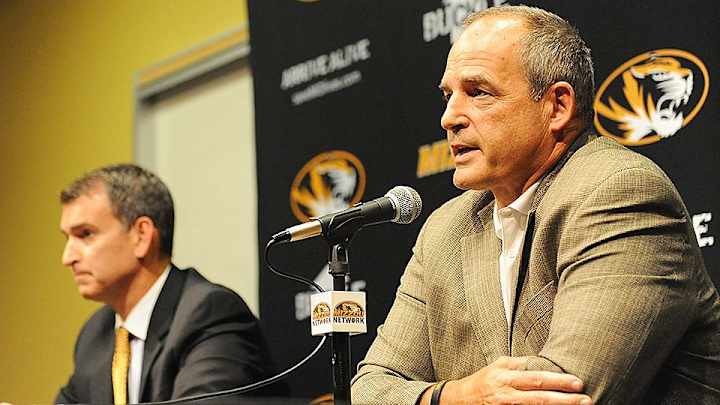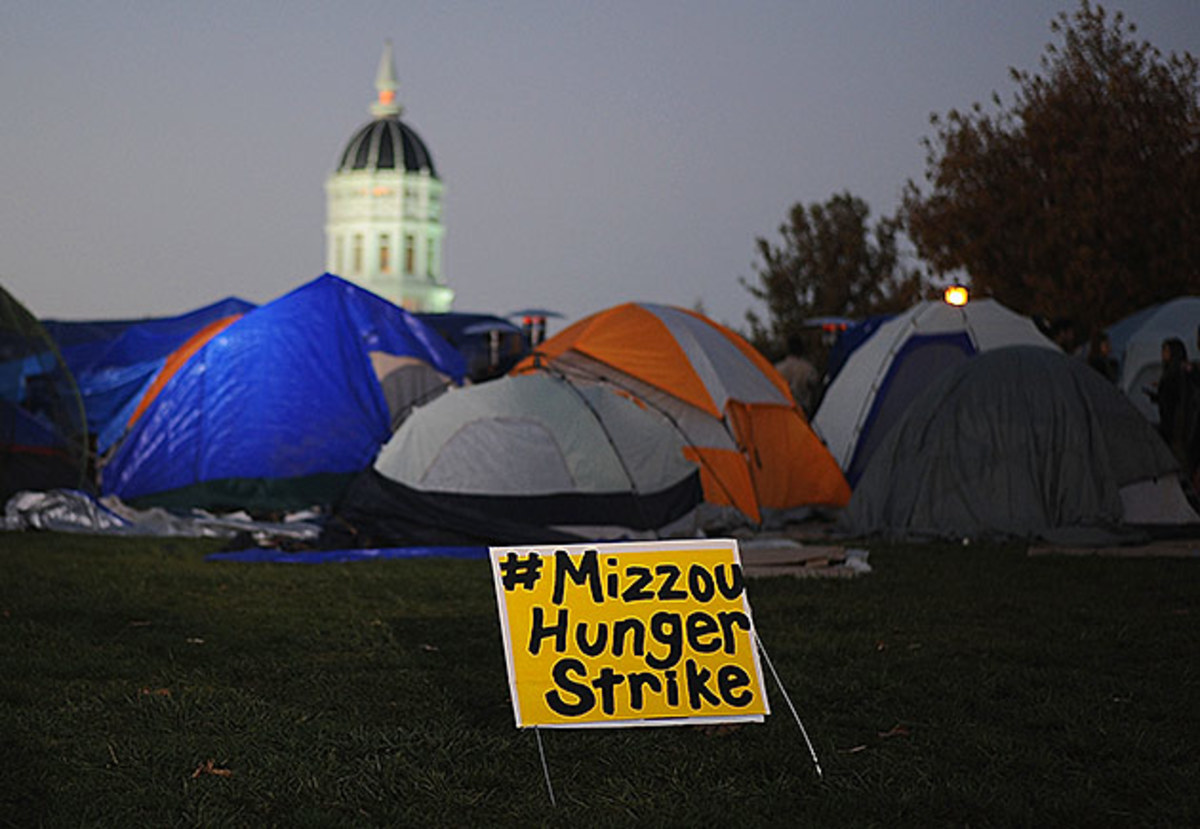Impact of Missouri football’s activism produces far-reaching, lasting effect

COLUMBIA, Mo. — This didn’t begin on Saturday night, when 32 Missouri football players tweeted an ultimatum to the world.
It didn’t begin last Wednesday, when sophomore receiver J’Mon Moore met with Jonathan Butler, the graduate student beginning a hunger strike that would only end if University of Missouri system president Tim Wolfe left office. No one knows when it started, not really.
Things have just been different this semester, black students and athletes at Missouri can agree. The campus alerts that used to beam out news of assaults and muggings now increasingly document racial issues, slurs and harassment that have become all too prevalent. Missouri’s Legion of Black Collegians (LBC) has grown accustomed to passersby yelling epithets at its gatherings, shouting words that should have died decades ago.
In recent weeks, tensions on Missouri’s campus mounted. Protesters came out for the homecoming parade. Email after email to Wolfe from upset students went unanswered. More and more, many black students began to feel that the administrators in charge of protecting their campus had no interest in addressing the problems at hand.
Why Missouri's football team joined a protest against school administration
Even the football team, which exists on a separate plane from the normal student body, began to notice. Over the course of the fall semester, several players made the acquaintance of Butler, who was at the forefront of the efforts to enact change and capture Wolfe’s attention. Those who met him were by and large impressed, and when Butler began his hunger strike on Nov. 2, they noticed. That same week, members of the LBC began to sporadically approach football players asking for their support. It would go so far in making a statement, they said. Players considered it, without any conception of how loudly their actions would speak, and after Moore’s meeting with Butler, loose planning began.
Saturday, players tweeted the ultimatum, and Sunday, when the team reconvened after its weekend off (Missouri lost to Mississippi State on Thursday night), coaches and players held a meeting. What emerged that afternoon was a show of solidarity from coach Gary Pinkel, who tweeted his support for his players’ demands and plan and effectively sanctioned the movement.
“You’ve promised to take care of these kids, and if they believe in something, you always tell them to stand up for what they believe in,” T.J. Moe, a receiver at Missouri from 2009 to ’12, says of Pinkel’s message. “But it’s a tough position for him. I don’t envy his position at all.”
And nothing about this has been simple. On Monday, a Missouri player who asked to remain anonymous said that the image put forth by the team suggested a far more organized objective than what players faced in reality. Not everyone had attended the Saturday meeting, and not all players agreed with the boycott. Even on Sunday, the player said, many were unsure as to exactly what path the team was following and what its objectives were. This perhaps explains the discrepancy in language between Saturday, when the team stated Wolfe’s removal from office as its goal, and Sunday, when it ceased to talk of firing and allied itself with Butler. It would not play, it said, until Butler ate. No mention of Wolfe, resignation or termination.
• STAPLES: Mizzou strike shows players, not the NCAA, hold real power
That same player also expressed disappointment that Wolfe’s job, from which he formally resigned on Monday, was the ultimate consequence of the team’s actions and Butler’s hunger strike. He feels as if Wolfe became a scapegoat, perhaps unfairly accused of racism when his real crime was a lack of interest in students’ welfare. Moe echoed that sentiment. He said he was discouraged that players seemed to pin all blame on Wolfe.
“It can’t always be the person in charge’s fault,” Moe said, and he expressed a wish that the demands focus more on finding and expelling the students responsible for the harassment on campus that led to much of the current unrest. Still, though, the anonymous player thinks the departures of the system president and university chancellor, R. Bowen Loftin, who announced his resignation Monday evening, will catalyze change in a way the previous administrators never cared to. The changes show that the school is committed to institutionalizing the change that the student activists have demanded all semester.

On Monday afternoon, after the football team had remained largely silent for much of the past 36 hours, it appointed captain Ian Simon, a senior safety, its spokesman. Joined by several teammates, including sophomore defensive lineman Charles Harris and Moore, Simon shuttled between the student center and a nearby quad where protesters have been camping out. Escorted by members of the organization Concerned Student 1950, the players were shielded from the media, and the student activists became adversarial as the football team deliberated and waited to read its message. When Simon finally spoke, his thoughts were concise.
“It’s not about us,” he said. “We just wanted to use our platform to take a stance for a fellow concerned student on an issue.… We will be ending our solidarity strike to not practice and returning to our normal schedule as football players.”
Heisman Watch: Deshaun Watson seizes top spot, Fournette struggles
He continued: “We love the game, but in the end of the day, it is just that: a game. Through this experience, we’ve really begun to bridge that gap between student and athlete in the phrase student-athlete by connecting with the community and realizing the bigger picture.”
In sum, the team’s message was that it is time to return to football, to the separate stratosphere in which it exists 99% of the time. But to do so will be an adjustment. The effect of what Missouri’s players orchestrated over the past 48 hours is still yet to be fully felt. Teammates supported the cause in varying degrees, with various reservations, and the ramifications of those differing perspectives will emerge.
“Hopefully we can move past this divide,” the anonymous player said.
• STAPLES: How Week 10 shattered our expectations about the season
There’s no blueprint for how to go about returning to normal, or finding a new normal for a group of young men who’ve just recently learned the power they can wield.
As the few players who gathered publicly on the quad Monday afternoon began to disperse, students again tried to bar them from speaking with the media. One woman admonished journalists.
“They’re not the story,” she said repeatedly. “Talk to your average black student.”
The team, in large part, echoed her sentiment, which, at face value, is correct. But at the same time, it can’t be true, not anymore. This is the Team That Boycotted. It is the story, and the force it set in motion is far from finished.
